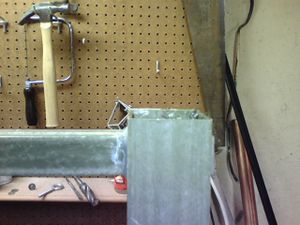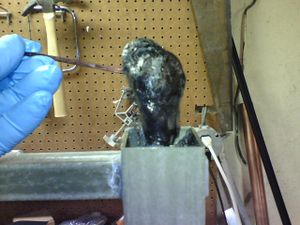CompositePage
Contents
Composite Construction Resource Page
2010 Goals
For the most part DEW Robots have been constructed out of aluminum and some plastic in the past. This build season I ( Gary Deaver) would like to introduce some basic carbon fiber and fiber glass construction techniques. We need to get some fiber in to DEW bot's diet. Properly used composites can help reduce weight while maintaining structural strength. Two types of composites that could be used are fiberglass pultrutions and carbon fiber laminated boards.
Fiberglass pultrusions
Fiberglass pultrusions are made of long fiberglass threads called tow and polyester resin. The come in many structural shapes like the aluminum that we use on the robot. Pultrusions can be machined with normal wood working tools. The dust from any fiberglass material needs health precautions. Gloves and a dust mask are recommended. Bedford Reinforced Plastics, Inc. is a manufacturer of pultrusions. This link will take you to their home page. Bedford Plastics There are many resources on their site. This page gives a description of how they are made. Pultrusion Process When working and designing with pultrutions, it is important to remember that if a hole is drilled into the piece, the long fibers are cut and a weak point is formed. While this is true for aluminum too, it is much worse for pultrusions. As a general rule try to avoid drilling. Clamping on to the pultrusion is better. For an example of fabricating with pultrusions look at the following picture. To make part of a ball grabber, we took a piece of 1.5" box tubing and mitered out a hole for a 1" box tube. Kind of like a mortise and tenon joint.
Laminated Composites
For the 2010 season the intention is to have a carbon fiber laminating project to introduce students to the the field of composite construction. A good candidate for this project is the electronics board. A piece of polycarbonate could be used with a support frame. This would be faster and easier. However the potential is to have a lighter and stiffer board by laminating a piece of 1/4" birch plywood with 1 layer of carbon fiber cloth on each side. Making composite parts can be very complex. We will strive to keep it simple. The first step to learning the skills to make the electronics board is to know what epoxy is. Follow the link below to a hand book on epoxies.
Now that you have a little understanding of epoxy and laminating, There are some more documents to study.
- West Systems Epoxy
- Applying cloth Watch the video if you want.
- Soller composites on cloth
- Some examples of different cloth
- Techniques

